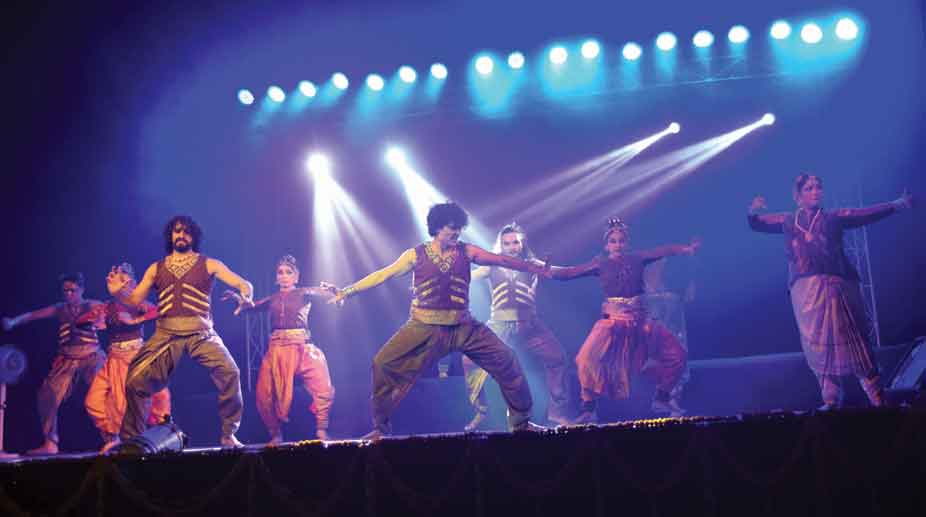Assam’s grand Jhumoir show: 8,000 performers, PM Modi to attend
Assam’s Jhumoir Binandini event on February 24 will feature over 8,000 performers showcasing the traditional Jhumoir dance at Sarusajai Stadium, Guwahati.

Dance
The Centre for Indian Classical Dances (CICD) premiered Divyalok, the Abode of Divinity, a new choreography of Sonal Mansingh, who, apart from being the founder-president of CICD, also happens to be one of the Navaratnas of Prime Minister Narendra Modi’s Swachh Bharat Mission. The thoughtfully-conceived and choreographed production was, therefore, focused around this important issue of national significance, but with the sensitivity of an artiste. The focus of this particular production was the concept of Swachh Vichar: Pure Thought, Swachh Vani: Good Speech and Swachh Vyavahar: Correct Behaviour, which are, in fact, the inner substance of our behaviour that can bring real cleanliness caused by the inner piety.
The three segments of Divyalok, namely Devi, Tripurasur and Kaliya, dealt with the initial purity with which the cosmos was created by Devi; the ungratefulness of Tripurasur from Shivapuran symbolising the filthy selfishness that is widespread in our minds and hearts; and the last segment Kaliya, symbolising the pollution of our rivers like Yamuna. Sonal’s deep research brings the story of “Devi” from Devi Bhagwat that Rishi Veda-Vyasa saw written on the soles of Devi, before the creation of this Srishti. Sonal conceived the Purvaranga, or preface of production, through this mythological story of Brahma-Vishnu-Mahesh representing the three Gunas Sattva, Rajas and Tamas.
Advertisement
With her research-based Sahitya, appropriate Sangeet by Shubhendra and Saskia Rao and Nritya choreographed by herself, Sonal Mansingh conveyed the message of cleanliness of thought in our minds, Vachan or Vani, or our communications with fellow human beings, and Karm, or deed in our daily behaviour, towards nature and environment with an impact, which was elevating and entertaining at the same time.
Advertisement
The Arthshila Festival, Patna
The Takshila Educational Society organised the annual Arthshila Samaroh in Patna on Kartik Purnima to revive the musical tradition of this city. The festival, held at the open air stage of DPS Patna, offered music in its entirety with Vocal (Gayan) by Vidushi Bombay Jayashri and Pt Ulhas Kashalkar, Sitar recital by Pt Shubhendra Rao and Nritya, or dance, by Guru Vanashree Rao and her dance group, the Rasa-United.
Vanshree’s Tripurasura Samhar and the other choreographies, based on 12 Jyotirlingas with reference to Markandeya Purana and Abhimanyu-Vadha presented there, have already been reviewed in this column but she had specially produced the Sindhu Bhairavi Tillana for this famed festival of Patna, which was premiered during the Arthshila Festival.
An impressive amalgamation of three different dance styles with dynamic dancers of Kuchipudi, Chhau and Bharatanatyam styles, the scintillating Tillana left the audience spell-bound. Written and composed by Vasudevan and Venkateshwara in the sonorous Swaras of Sindhu-Bharavi, the musical score of the Tillana comprised Nattuvangam by Vasudevan, Percussions by Kesavan, Flute by Rajat Prasanna, Violin by Raghavendra and light design by Sharad Kulshreshtha. The challenging martial arts movements of Chhau, the captivating Jatis of Bharatanatyam and the delicate grace of Kuchipudi that also incorporated Tarangam, the typical dancing on the edge of Brass plates; totally mesmerised the audience. The Sahitya in the concluding Sanskrit Shloka of the subtly choreographed Tillana, symbolising Shiva depicted in five elements, the Panch-Mahabhoot, brought it to the resounding climax, getting a standing ovation.
The Bhavan Sangeet Samaroh
The Delhi Kendra of Bharatiya Vidya Bhavan (BVB) celebrates its Founder’s Day on 7 November, when it was established by K M Munshi, way back in 1938, with its annual Sangeet Samaroh on 6-8 November every year. The Shikhar Samman was awarded this year to Vidwan T V Shankarnarayan. The three-day festival had two dance presentations also along with the Vocal and Instrumental music recitals, by eminent artistes. Priyadarshini Govind gave a Bharatanatyam recital on the second day and Gauri Divakar performed Kathak on the concluding evening.
The SNA Ud Bismillah Khan Yuva Puraskar awardee Gauri presented the traditional repertoire of Kathak first in the challenging Tala of nine beats cycle with Thaat, Uthaan, Tode, Tukde, Paran, Pramelu et al and later in Teentala with some more Chakkardar tukde, Paran and also a couple of Gats, first the simple one and then a la Sitara Devi, dedicated to her memory. Gauri also presented a hurried glimpse of Thumri in between to two pure dance sequences. The rare Thumri was a lovely composition of her Guru Pt Jaikishan Maharaj, set to 21 beats cycle divided into Dadra, Rupak and Kaherwa Talas of 6+7+8 beats respectively. The musical interlude on Sitar in raga Bageshri was a melodious piece of music, while she changed her designer costume.
Advertisement